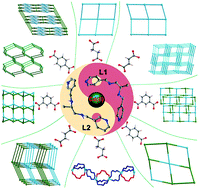Cd(ii) coordination polymers constructed from bis(pyridyl) ligands with an asymmetric spacer in chelating mode and diverse organic dicarboxylates: syntheses, structural evolutions and properties†
Abstract
Self-assembly of diverse Cd(II) metal salts, four organic dicarboxylic acids, and two flexible bis(pyridyl) ligands leads to the formation of thirteen complexes, namely, [Cd(L1)(C4H4O4)]n (1), [Cd(L2)(C4H4O4)0.5]n·nOH·8nH2O (2), [Cd(L1)(C4H2O4)]n (3), [Cd(L1)(C4H2O4)]n (4), [Cd2(L2)(C4H2O4)2(H2O)2]n·nH2O (5), [Cd2(L1)(m-BDC)2(H2O)2]n (6), [Cd2(L2)(m-BDC)2(H2O)2]n (7), [Cd3(L1)2(p-BDC)3(H2O)4]n·2nH2O (8), [Cd(L2)(p-BDC)0.5Cl]n (9), [Cd(L2)(p-BDC)0.5(H2O)]n·n(ClO4)·nH2O (10), [Cd3(L2)2(p-BDC)(SO4)2(H2O)6]n·4nH2O (11), [Cd(L2)(p-BDC)]n·nH2O (12) and [Cd(L2)(p-BDC)]n·nMeOH (13) (L1 = N,N′-bis(pyridin-4-ylmethyl)propane-1,2-diamine, L2 = N,N′-bis(pyridin-3-ylmethyl)propane-1,2-diamine, m-BDC2− = m-benzene dicarboxylate dianion, p-BDC2− = p-benzene dicarboxylate dianion), which have been characterized by elemental analysis, IR, TG, PL, and powder and single-crystal X-ray diffraction. The influence of different Cd(II) salts on the structure variations and properties has also been investigated. Complexes 1 and 3 present a (4,4) layer motif accomplished by the interconnection of adjacent Cd(II) cations through L1 molecules and trans-conformational succinates or fumarates. In contrast, the cis-conformational succinates in complex 2 only afford the formation of a chain structure. The L1 and L2 molecules in complexes 4 and 5 adopt the same coordination and join adjacent Cd(II) cations together with fumarates, giving rise to different 3D networks with vma and irl topologies. The same coordination mode of L1 and L2 in complexes 6–8 joins adjacent Cd(II) cations together with aromatic dicarboxylates, leading to different (63)(65·8), 2-periodic (6·3) and (4·4) layer motifs. The L2 molecules in complexes 9–13 present different coordination modes and join adjacent Cd(II) cations together with p-BDC2− dianions to form diverse (6·3) layer motifs, and different 3D networks with cds and eca topologies. Therefore, the diverse coordination modes of the bis(pyridyl) ligand and the feature of different organic dicarboxylate anions can effectively influence the topological structures of these complexes. Luminescence investigation reveals that the emission maximum of these complexes varies from 403 to 433 nm in the solid state at room temperature.



 Please wait while we load your content...
Please wait while we load your content...